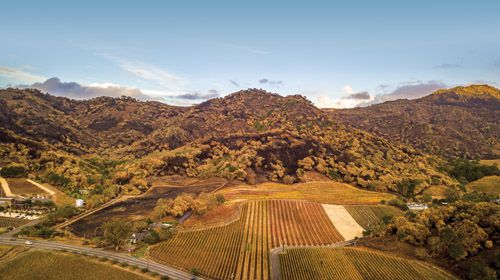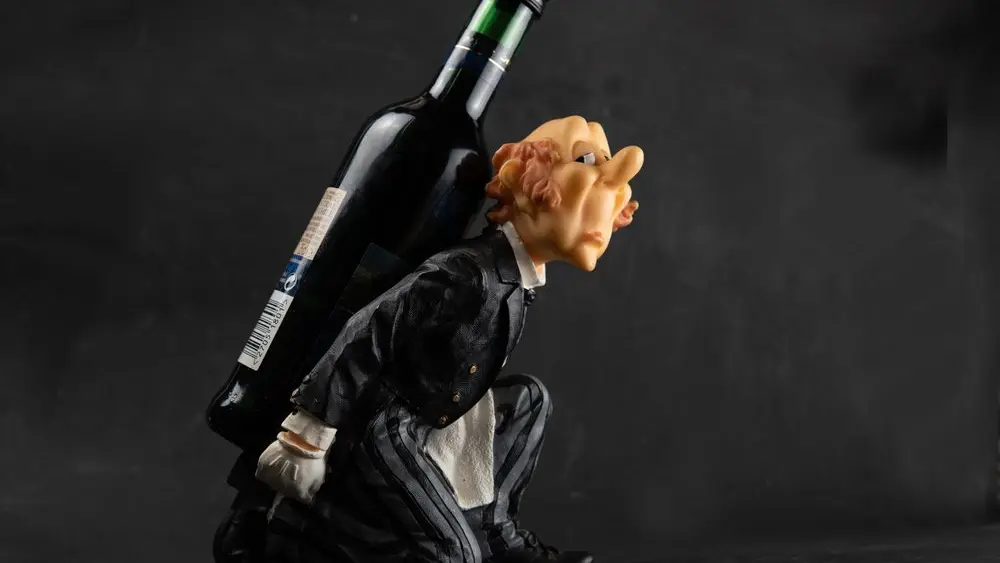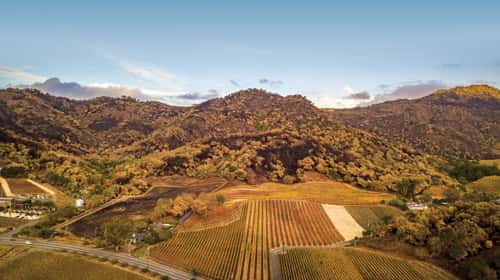
When the phone rang at 11 p.m. on October 8 last year, Lyall and Karen Fahden did not yet smell smoke. A friend from nearby Calistoga had called to warn them that a fast-moving fire was heading toward their home and winery. They dressed quickly and drove through their vineyards toward the nearby ridge. As they neared the top, they noticed the silhouette of the mountain was edged with an eerie red glow that pulsed and grew in intensity as they approached. By the time they reached the top and gazed down, it appeared that the entire valley was in flames.
“We just stood there and looked on in awe—it was horrific to witness,” Karen recalls. “The fire had already reached the valley directly below us, and we watched as our neighbors’ houses just burst into flames. We could see headlights, hear voices and shouts—it just looked like everything was engulfed in fire. I’ll never forget the roar—the strange sing-song cacophony of the flames mixed with wind and the occasional shouting.”
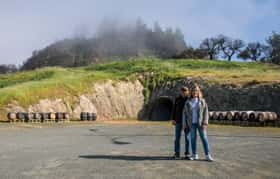 The couple was talking about the harrowing experience of staying on their property and helping fight the fires that ripped through Wine Country in October 2017. Their home and their Hans Fahden Vineyards remain at 4855 Petrified Forest Road, which is directly in the path of what eventually came to be known as the Tubbs Fire.
The couple was talking about the harrowing experience of staying on their property and helping fight the fires that ripped through Wine Country in October 2017. Their home and their Hans Fahden Vineyards remain at 4855 Petrified Forest Road, which is directly in the path of what eventually came to be known as the Tubbs Fire.
One of many fires in the region during the same period, the Tubbs fire had started north of Calistoga and swept westward toward Santa Rosa, where it leveled neighborhoods that included Coffey Park and Fountaingrove, as well as numerous mobile-home parks and homes. The Tubbs Fire became one of the most destructive single wildfires in the history of California, burning more than 36,000 acres and resulting in 22 deaths and thousands of destroyed structures.
At the same time, other fires in Wine Country sprang to life and collectively consumed more than 200,000 acres, nearly 10,000 structures and 44 lives. The fires hospitalized 185 people, destroyed thousands of vehicles, killed untold numbers of livestock and native animals, and were the costliest group of wildfires on record. They caused at least $9.4 billion in insured damages and are predicted to cost the U.S. economy billions in lost tax revenue from destroyed businesses, displaced workers and disruptions to tourism. At about the same time, other fires up and down California were also raging, making 2017 the most destructive wildfire season on record, totaling more than 9,000 fires. According to the California Department of Forestry and Fire Protection, the number of burned acres reached 1,381,405, which, for perspective, is equal to more than 1 percent of the entire state’s land mass.
Natural firebreaks
Vineyards often hindered the progression of fires in the October 2017 firestorm. According to some, the fire damage within the state’s many wine-growing regions might have been far worse if not for the many vineyards.
“The vineyards often acted as firebreaks,” says Lyall. “Not in all situations, but it’s clear that they helped slow or even stop the progression of the fires, at least sometimes. That said, if the 80-mile-an-hour wind had turned toward you that night, you were toast—with a fire that fierce, there’s almost no stopping it.”
The opinion that vineyards helped to slow or even stop the progression of fires is widespread and easily reinforced with photos of the devastation that show blackened hillsides just days after the fires that contrast with adjacent green vineyards.
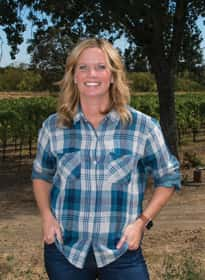 “While the October fires brought great devastation, we continue to learn of the raw power of Mother Nature,” says Karissa Kruse, president of the Sonoma County Winegrowers. “We’ve heard repeatedly and documented with photos where vineyards stopped flames and acted as firebreaks throughout Wine Country and saved homes, structures and communities.”
“While the October fires brought great devastation, we continue to learn of the raw power of Mother Nature,” says Karissa Kruse, president of the Sonoma County Winegrowers. “We’ve heard repeatedly and documented with photos where vineyards stopped flames and acted as firebreaks throughout Wine Country and saved homes, structures and communities.”
An interesting feature of many of the local fires was that the damage didn’t seem to penetrate far into the interior of the vineyard, and even at the scorched edges many vines seemed nearly unaffected.
In fact, of the 2,482 acres of vineyards in the areas affected just within the limits of the Sonoma County fires, only around 92 acres were damaged, according to a report presented by the Sonoma County Winegrowers to California’s Senate Select Committee on California’s Wine Industry Assembly on Wine Fire and Industry Recovery Update Panel on April 6, 2018. The report concluded that vineyards, agricultural reservoirs and farmers were all part of the solution during the October wildfires.
Still, there is general reluctance to call vineyards “firebreaks.”
“Vineyards did slow the movement of the fires in some sites and ‘saved’ some structures because the vines separated those structures from the large fuel sources—for example riparian corridors and chaparral or oaks—some people call that a firebreak,” said viticulture farm adviser, Rhonda Smith of the University of California.
Cooperative Extension.
Local firefighter agencies point to vineyards as but one part of a complex collection of variables when it comes to fire control.
“We really can’t say that vineyards act as firebreaks in all conditions,” says Geoff Belyea, assistant chief of the Napa County Fire Department. “Certainly we often found vineyards acting as roads or other similar farmland, but fire containment is a function of many factors—weather, terrain, firefighting resources and others—and is case-specific.”
A firebreak is defined as a natural or constructed barrier used to stop or check fires that may occur, or to provide a control line from which to work, according to the National Park Service and USDA Forest Service.
Call the vineyards firebreaks or not, but what’s clear is they often played a role in slowing down and/or altering the course of at least some of the fires.
“It is clear that vineyards—along with other vegetative control measures such as grazing, thinning and removal of fuel accumulation around homes—may have helped provide extra time for those that needed to evacuate,” Belyea says. “Throughout the fires, a coordinated effort between fire and police allowed the evacuation of thousands. I hope we never have to go through that again, but this has reinforced the need to coordinate efforts to reduce the threat and continue to improve communication and outreach.”
How a vineyard affected a fire’s path seems linked to its orientation, how it was managed and the surrounding terrain.
“What we’re noticing is that when the vine rows were orientated to block (horizontal) advancing fire and if the vineyards had been mowed, tilled or clean-tilled under the vines, that seems to have made a difference in some cases,” said Duff Bevill, owner and operator of Bevill Vineyard Management.
Row orientation
Row orientation can act as a wall or row for fire. “There were some of our vineyards that were orientated so that when the wind pushed the fire it just ran straight down the row to the other side,” Lyall says. “Luckily, as the fire approached our home and winery the orientation was such that it helped stop the fire. Of course we had also spent years working in anticipation of fire — we’d gone through it before in 1964 and knew that another one would be coming at some point.”
With high winds the fire often passed over smaller vineyards or was carried farther downslope.
On the very same night the Tubbs Fire in Calistoga had started, another fire, the Atlas Peak Fire, had begun in the rugged hills just east of the city of Napa. Like Tubbs, this fire was devastating and resulted in six deaths, hundreds of destroyed structures, thousands of acres scorched, and nine wineries damaged or destroyed.
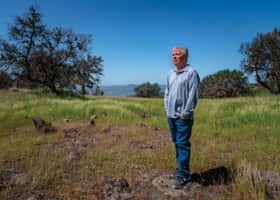 Years earlier, Randy Wulff and his wife, Krys, had purchased a home and started a small vineyard and winery (Lobo Wines) in Atlas Peak. By day, Wulff was a trial lawyer before becoming a mediator, recently spending two and a half years as the arbitrator resolving all the property-damage claims arising from 9/11 at the World Trade Center site, and also as mediator in the recent post office cases against Lance Armstrong. He and his wife had purchased the home 1,000 feet above Napa where they might relax. But that night they were lucky to make it out alive.
Years earlier, Randy Wulff and his wife, Krys, had purchased a home and started a small vineyard and winery (Lobo Wines) in Atlas Peak. By day, Wulff was a trial lawyer before becoming a mediator, recently spending two and a half years as the arbitrator resolving all the property-damage claims arising from 9/11 at the World Trade Center site, and also as mediator in the recent post office cases against Lance Armstrong. He and his wife had purchased the home 1,000 feet above Napa where they might relax. But that night they were lucky to make it out alive.
“That fire was not just a fire—it was a meteorological event,” Wulff says. “I was in the house with our cats; fortunately my wife was traveling. For some inexplicable reason I could not go to sleep that night and got up and looked up the hillside and it was a complete wall of fire—the flames were taller than the treetops and were blowing right at the house. I knew I had only five minutes.”
Gathering the cats, Wulff jumped into the car and raced down the winding hill. In his rearview mirror he saw his house go up in flames, “just like a match head,” and the fire skimming over the vineyard and roads as it raced through the treetops, new fires leap-frogging down the mountainside.
“The fire seems to have jumped right over the vineyard to the adjacent oak trees,” Wulff says. “We had a couple of smaller vineyards right between us and the oncoming fire, and that might have helped slow it down but it certainly didn’t stop it.”
Many vineyards that burned seem to be coming back to life. “Because we were at the end of the growing season, many of the vines had already begun to shut down,” Bevill says.
The science of assessing the impact of fire on a vineyard is inexact, and it’s possible that early evaluation of vine health may have benefited from more time.
“After the fires, we went through the vineyard and clipped vines to determine the damage,” Wulff says. “For many of those vines on the edge of the vineyard the damage was just too great and you could see that they’d not be able to transfer enough liquid—they were just not going to make it. We ripped most of those vines out. But it was also surprising how many vines that I thought were lost actually seemed to do just fine now and have pushed buds this spring.”
Time will tell
“In my vineyard visits, it’s not as easy as it reads,” Smith says. “The decision to remove a significant number of vines that currently appear more or less okay is not science-based. Bottom line, there’s no single method that is tried and tested true. It is a pragmatic, common-sense approach to weighing the ROI of either rehabilitation or replacement. People are making decisions now; the vines are ‘speaking for themselves’ and have either pushed buds and are growing a sufficient number of shoots in the appropriate places, or they are not.”
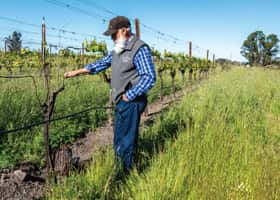 Across the region wine-grape growers are surprised by the vines’ resilience.
Across the region wine-grape growers are surprised by the vines’ resilience.
“In the 40-acre vineyard near Coffey Park it first appeared like there was more damage, but today it looks like we only lost one vine,” Bevill says. “At the time, I wasn’t sure what was going to happen. I’ve been farming for 45 years and never seen anything like this before. I was happily surprised that we’re not seeing more damage in the vineyards.”
Although even grapevines damaged in the fires appear to be recovering well, there remain concerns that the plants have absorbed some of the smoke elements from the fire, which might compromise the 2018 harvest. The science remains inconclusive on how and if this is a certainty or only a concern, but growers are watching and waiting.
Learning from fire
Since the fires have ended, everyone from farmers to statewide agencies have started to collect, analyze and share data that might help improve outcomes for future fire emergencies.
“Immediately after the fires we convened a group called the Watershed Collaborative that is comprised of more than 150 individuals and 60-plus organizations,” says Karen Gaffney, conservation planning manager for the Sonoma County Agricultural Preservation and Open Space District. “The collaborative included several working groups, one of which was focused on working lands. We compiled the priorities into a document called “Living in a Fire Adapted Landscape.” A strong priority of Sonoma County Agricultural Preservation and Open Space District—shared by many in the working-lands group—was the documentation of how different parts of the landscape fared in the fires due to different vegetation cover, land management and land cover.”
According to Gaffney, part of the interest was to “objectively and rigorously evaluate the informal evidence that agricultural lands helped to mitigate the intensity of the fire or act as a firebreak (whether cultivated for vineyards and other crops or rangelands), as well as to look at any correlation between land management and fire intensity and severity, vegetation response to the fires and loss of carbon stocks in the burn zones.”
But like nearly everyone in the region, Gaffney’s interest has a personal side, too.
“We wanted to expand on a significant amount of informal and anecdotal evidence from people like me, who experienced first-hand how the vineyards across from my home on Chalk Hill Road stopped the fire in the forest about 100 feet from my house,” Gaffney says. “We are actively participating in conversations about how our work can help to support agricultural and other types of land conservation that will make our county and its communities more resilient to fire-, flood- and climate-change-driven extreme events.”
Planning for the future
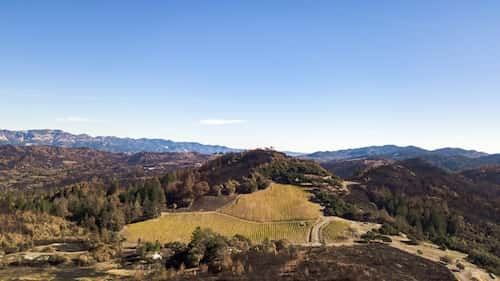
As communities continue to rebuild, one concept that seems to be on everyone’s minds is how vineyards and other green spaces can be better utilized to help reduce the impact of future fires.
“I wonder if communities in the future might consider vineyards as potential firebreaks between neighborhoods,” says Bevill. “It might be an interesting way to help manage fires and provide a defensible space that could limit the devastation that we witnessed recently.”
The Fahdens have the same question: “How might vineyards be used in the future to help control or deter fires?” Karen asks.
These questions came after what was a devastating fire, but on that first night they had more immediate questions on their minds as they stood gazing out at the advancing “river of fire” that headed toward them.
“We’d been preparing for that fire in some ways for our entire lives,” says Lyall. “We had planned and prepared fire roads and created many ponds to supply firefighters and also spray down our buildings.”
Over those touch-and-go days of the early fire, together with family, friends and a community of firefighters and law-enforcement officers, they worked day and night, doing what they might to save what they could. At times all seemed lost as the fires twisted and whipped in the wind, followed by a brief pause but only a moment’s peace before it might start up again in another location, another threat to life, limb and livelihood.
“Our son had come up to help, and we both went out to find Lyall a couple of days after the fire had started but was still going strong,” says Karen. “We could hear the hum of the tractor in the distance, and we followed the trail deep into the woods—smoldering fire and smoke everywhere.”
When they eventually found Lyall, he was cutting a firebreak between their property and the neighbors’, hoping to slow the flow of the fire. Unbeknownst to them, back at their home the fire had twisted around the hill and headed straight for their house before being stalled by a vineyard in its path. But out there in the woods that day, Lyall continued on, his face black with soot, his lungs heavy with smoke.
“We stood there watching him driving the tractor right at the fire,” says Karen. “He’d see a tree that was burning and go straight at it, knocking it down and stopping the flames from spreading further. I wasn’t sure, I thought I might stop him, ask him to turn back, but there was no back. There was only forward.”
Author
-

Tim Carl lives, writes and teaches in Calistoga. He grew up in St. Helena and traces his Calistoga grape-growing roots back five generations. You can reach him at tcarl@northbaybiz.com.
View all posts


